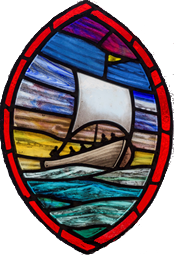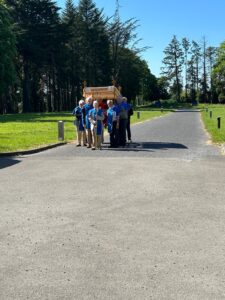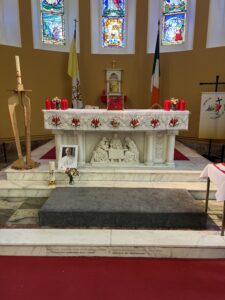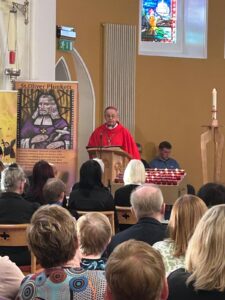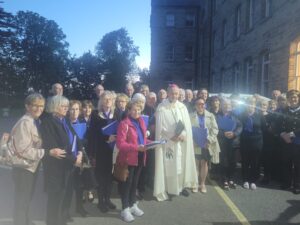Relics of St Oliver Plunkett Visit Kilmore Diocesan Pastoral Centre

Relics of St. Oliver Plunkett visited the Conaty Chapel of the Kilmore Diocesan Pastoral Centre in Cavan on Wednesday 21 May last. The visit was of special significance as 2025 marks the 400th anniversary of the birth of St Oliver and the 50th anniversary of his canonisation by Pope St Paul VI. This was also the 10th occasion the Centre hosted the relics with the assistance of the Knights of St Columbanus in Drogheda and Cavan.
Local members of the Knights of Saint Columbanus carry the relics of St. Oliver Plunkett in procession through the grounds of the Diocesan Pastoral Centre at the beginning of the day.
The relics arrived at the Centre for a Liturgical Welcome celebrated by Bishop Martin Hayes at 10:00a.m. and were available for veneration until 10:00p.m. that evening.
The relics of St. Oliver Plunkett rest on the altar of The Conaty Chapel in the Diocesan Pastoral Centre
Bishop Martin prays before the relics of St. Oliver Plunkett
There was a lunch-time Mass in the Chapel at 1:15p.m. celebrated by Fr Jason Murphy assisted by Fr Andrew Tully. Fr Jason also preached the homily. This Mass was offered for those about to sit examinations around this time and was attended by a number of students from local post-primary schools.
Monsignor Liam Kelly, PP Ballyconnell and Vicar General of the Diocese celebrated Mass at 5:45p.m. for the deceased members of the Knights of Saint Columbanus in the Diocese of Kilmore and delivered the homily.
Bishop Martin Hayes was the principal celebrant and homilist at the 8:00p.m. Mass .The music for this Mass was provided by the choir from St. Michael’s Church in Cootehill under the direction of Mrs Bernadette Curtis.
Bishop Martin Hayes celebrates Mass during the visit of the relics
Bishop Martin Hayes blesses the congregation with a relic of St Oliver
Bishop Hayes presided at a Liturgical Farewell before the relics left the Chapel for their return to Drogheda.
Bishop Martin with the Members of the St Michael’s Church Choir in Cootehill following the Liturgical Farewell to the Relics
There were opportunities to avail of the Sacrament of Reconciliation during the course of the day.
Local Civil Defence personnel were also in attendance throughout the day.
St. Oliver Plunkett was born at Loughcrew, near Oldcastle in Co. Meath on 1 November 1625. Having studied at the Irish College in Rome, he was ordained a priest in 1654 and became Archbishop of Armagh and Primate of All Ireland in 1657. He maintained his duties in Ireland in the face of English persecution, reorganising the ravaged Irish Church, but was eventually arrested and tried for treason in London. Having being found guilty of high treason on perjured evidence, he was hanged, drawn and quartered at Tyburn on 1 July 1681, and became the last Roman Catholic martyr to die in England. Oliver Plunkett was beatified in 1920 and canonised in 1975 by Pope Saint Paul VI, the first new Irish saint for almost seven hundred years.
The Catholic Church categorises relics from saints in three: first, second and third class. Body parts such as blood, bones or even ashes of a saint fall under the first category. Clothing worn by the saint, such as liturgical vestments, are considered second class, and personal possessions third. Catholics venerate the remains of a saint as an expression of reverence for their holiness of life, and to seek the saint’s intercession for spiritual aid, healing, and particular graces.
